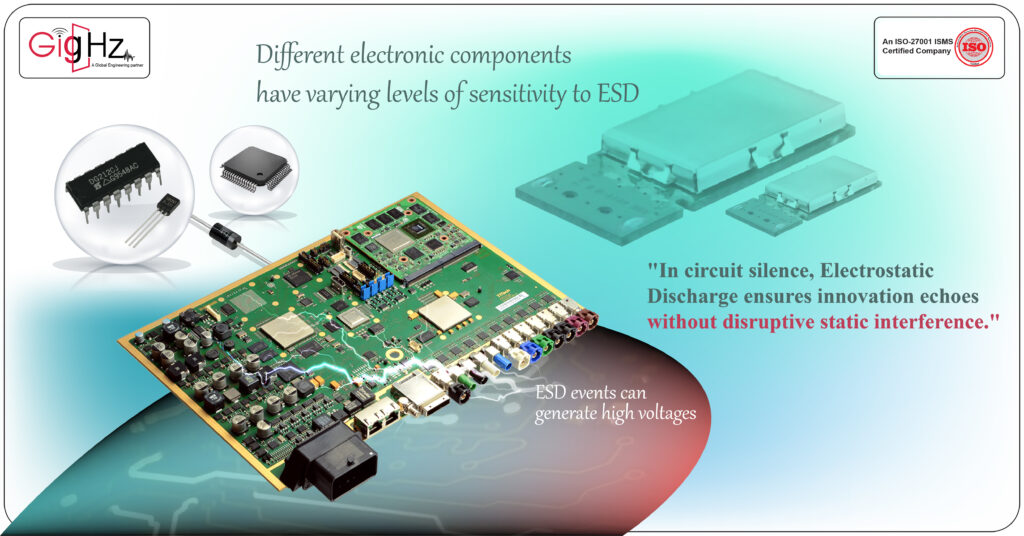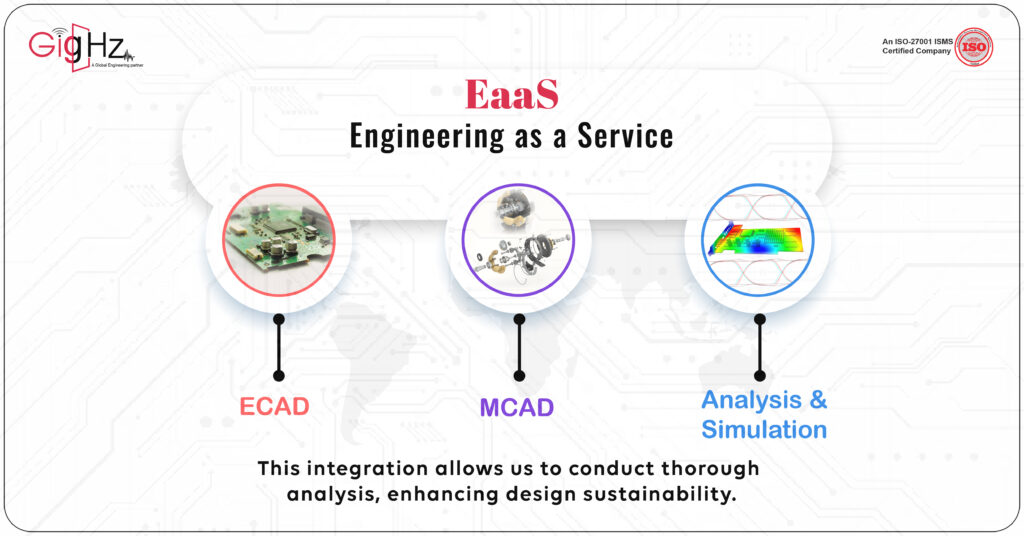Are Capacitors Effective for ESD Protection? Let’s Find Out!
Greetings, tech enthusiasts!
As technology continues to advance at a rapid pace, it’s essential for us to understand how electronic devices are protected against the dangers of electrostatic discharge (ESD)?

Here at GigHz, we’re in the business of turning “impossible” into “done.”
We thrive on tackling complex challenges and transforming them into innovative solutions.
Recently, we had the chance to flex our problem-solving muscles when a client came to us with a tricky situation involving a hosted payload sensor data collection in their spacecraft.

Category :
Published Date :
January 30, 2024
Category :
Published Date :
January 30, 2024
Category :
Published Date :
January 30, 2024
In this blog post, we’ll delve into the world of capacitors and explore their vital role in safeguarding our precious gadgets from ESD.
ESD poses a significant threat to electronic devices, as it can cause malfunctions, data loss, or even irreparable damage.
To combat this, manufacturers implement various protective measures, with capacitors playing a crucial part in ESD protection.
Capacitors are electronic components that store and release electrical energy. They consist of two conductive plates separated by an insulating material known as a dielectric.
When a voltage is applied, a potential difference is established, and the capacitor stores electrical charge.
During an ESD event, capacitors act as a shield, absorbing and redirecting excess electrical charges away from sensitive components.
But just how effective are capacitors in ESD protection? Let’s find out!
Throughout this blog post, we’ll explore the mechanisms by which capacitors provide ESD protection. We’ll discuss their role as energy buffers, the diversion of excess charges, voltage clamping capabilities, and their ability to filter high-frequency transients.
Additionally, we’ll highlight how capacitors contribute to the overall reliability and longevity of electronic devices.
Understanding the importance of capacitors in ESD protection will not only deepen our knowledge of the inner workings of our beloved gadgets but also empower us to make informed decisions when it comes to device selection, maintenance, and troubleshooting.
So, if you’re ready to unravel the mysteries behind ESD protection and discover how capacitors serve as the first line of defense for our electronic devices.
Let’s dive right in!
Understanding Electrostatic Discharge (ESD)

Electrostatic discharge occurs when a sudden flow of electricity happens between objects with different electrical potentials.
This discharge can result from human contact, friction, or induction, and it poses a significant risk to sensitive electronic components. To mitigate the potential damage caused by ESD, effective protective measures must be in place.
ESD events can generate high voltages, reaching several thousand volts in a very short duration.
The discharge occurs due to the rapid movement of electrons from a high potential object to a lower potential object.
It can produce currents ranging from a few amperes to hundreds of amperes, depending on the energy involved.
ESD Sensitivity of Components:
Different electronic components have varying levels of sensitivity to ESD. Integrated circuits (ICs), transistors, diodes, and memory chips are particularly susceptible to damage from ESD.
The sensitivity of components is often quantified using an ESD rating, such as the Human Body Model (HBM), Machine Model (MM), or Charged Device Model (CDM).
ESD Failure Mechanisms:
ESD can cause various types of failures in electronic components, including catastrophic failures, functional failures, and latent failures.
Catastrophic failures occur when the component is permanently damaged or destroyed due to excessive voltage or current.
Functional failures are temporary malfunctions that can be resolved by power cycling or resetting the device.
Latent failures occur when the component is partially damaged, leading to reduced reliability and potential failure over time.
ESD Protection Strategies:
ESD protection strategies involve implementing measures to prevent or reduce the effects of ESD events on electronic devices.
These strategies include proper grounding and bonding techniques, shielding, humidity control, and the use of ESD protective equipment (e.g., wrist straps, mats, and conductive packaging).
Additionally, ESD protection devices, such as transient voltage suppressors (TVS diodes), metal-oxide varistors (MOVs), and ESD protection ICs, are commonly employed to divert and absorb excess electrical energy during an ESD event.
What’s the role of Capacitors in ESD Protection?

Capacitors play a vital role in protecting electronic devices against ESD events.
These passive electronic components store and release electrical energy when needed.
When integrated into the circuitry, capacitors act as reservoirs, absorbing excess electrical charges generated during an ESD event.
By doing so, they help divert the potentially harmful current away from sensitive components, safeguarding them from damage.
The energy storage capability allows capacitors to absorb and limit the instantaneous discharge of excess electrical charges, protecting sensitive components from damage.
These capacitors gradually release the stored energy, dissipating it over time and reducing the impact on the system. Choosing suitable capacitors for ESD protection is crucial.
It is suitable for ESD protection should have a sufficiently high capacitance value to effectively absorb and store electrical charges during an ESD event.
Capacitors with low equivalent series resistance (ESR) and equivalent series inductance (ESL) are preferred to ensure efficient energy storage and dissipation.
It is crucial to choose capacitors with appropriate voltage ratings that exceed the expected voltage levels during an ESD event to prevent breakdown or failure.
In addition to dedicated ESD protection components, bypass capacitors are commonly employed in electronic circuits to provide localized ESD protection.
Placing bypass capacitors near sensitive components or integrated circuits helps to reduce the risk of ESD-induced failures by shunting away transient currents and voltages.
Also, act as low-impedance paths for high-frequency noise and ESD events, improving the overall system’s immunity to ESD.
PCB Layout Considerations:
Considerations must be given to PCB layout techniques to enhance the effectiveness of capacitors in ESD protection.
Proper PCB layout techniques can enhance the effectiveness of capacitors in ESD protection.
Placing capacitors close to the components they protect minimizes the path length for charge absorption and reduces parasitic inductance and resistance.
Careful consideration should be given to the trace routing and placement of capacitors to minimize the risk of unwanted coupling and interference
ESD Simulation and Testing:
Simulation tools are available to evaluate and optimize the performance of capacitors and overall ESD protection in electronic systems which is crucial to validate the effectiveness of capacitors and other protective measures.
Compliance with industry standards and specifications, such as IEC 61000-4-2 for ESD immunity, ensures that the capacitors provide the necessary protection against ESD events.
Considerations for Selecting Capacitors for ESD Protection
When selecting capacitors for ESD protection, several factors come into play,
ESD Ratings: Capacitors designed for ESD protection often come with specified ratings, indicating their ability to withstand and dissipate electrical charges effectively. It is crucial to choose capacitors with appropriate ratings suitable for the intended application.
Capacitor Types: Different types of capacitors, such as ceramic, tantalum, or film capacitors, exhibit varying characteristics and performance. Understanding the specific requirements of the circuit and consulting relevant datasheets will aid in selecting the most suitable capacitor type.
Circuit Placement: Strategic placement of capacitors within the circuit is essential for optimal ESD protection. Identifying critical points and integrating capacitors accordingly ensures the best possible shielding against electrostatic discharge.
Engineering as a Service(EaaS)

You know, as the need for advanced and integrated engineering solutions keeps soaring, our Engineering as a Service (EaaS) are really stepping up the game.
We’re harnessing the power of ECAD, MCAD, and Analysis & Simulation.
This gives us a great position to be frontrunners in this industry.
What’s really cool is that we offer a full package, covering every single step of the engineering process.
And honestly, it’s this kind of approach that’s going to shape the future of our engineering.
It’s exciting stuff!
Why we do?
We challenge our Engineering capabilities with emerging technologies to keep your time and cost in control, thereby transforming product design with human touch quality.
Conclusion
All in all, this article gives a lot to consider when it comes to the effectiveness of capacitors for ESD protection. We’ve seen that there are many things to look at before making a decision on the right component for the job.
Hopefully, this article has provided you with some insight into what capacitors will work best for you and common pitfalls you can avoid.
Consider your requirements and goals thoroughly, and don’t skimp too much on quality.
If you do decide to use capacitors for your ESD protection project, ensure their performance is checked regularly to get the most out of them.
Discover our specialties. Visit our Services Pagehttps://gighz.net/services/
Don’t forget to keep an eye on the ESD trends in the industry,
Schedule a call. Book a Free Consultation now. https://calendly.com/gighz/30min
